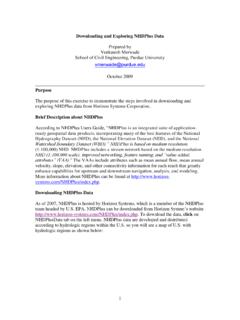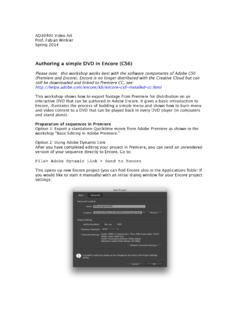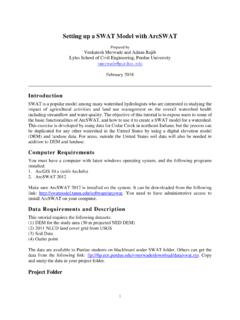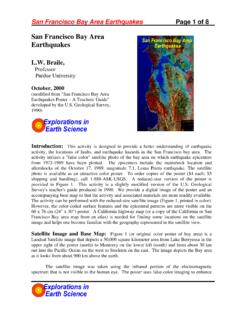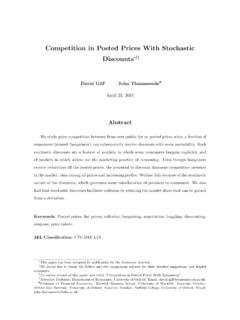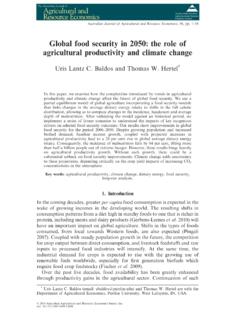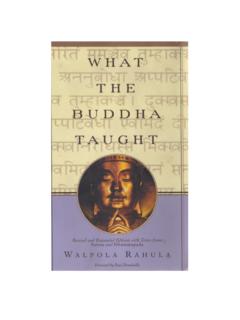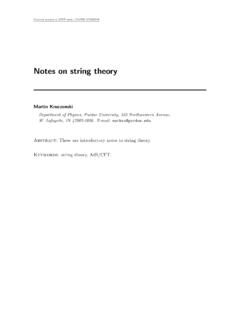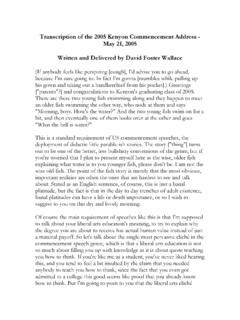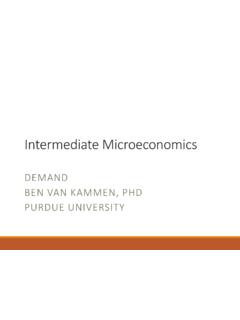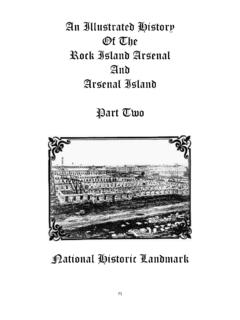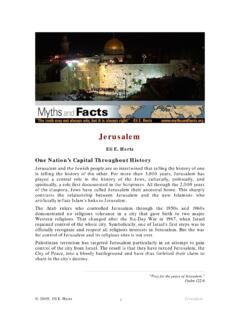Transcription of Study Guide to Textbook Foundations of Earth Science
1 Study Guide 8/2010 EAS 100 Study Guide to Textbook Foundations of Earth Science (Lutgens and Tarbuck, 6th edition, 2011) The Textbook for EAS 100, Foundations of Earth Science , by Lutgens and Tarbuck is an excellent book. It is up-to-date, "readable", has good illustrations and an appropriate treatment of the four subject areas - Earth Science , Oceanography, Atmospheric Science , and Astronomy - which constitute the subject matter for EAS 100. The book is of appropriate length for a one-semester course and the authors make an attempt to emphasize and identify fundamental concepts and terms and to illustrate these concepts with relevant and significant examples.
2 Despite the quality of this Textbook , the reader may "get lost" in the volume of material and in the detailed and extensive terminology that is used in the book and that is somewhat characteristic of these subject areas. This detail and terminology is necessary in a Textbook in order for the book to be complete, authoritative, and useful as a reference. An example of this detail is the use of key terms (in bold print in the chapters and listed at the end of each chapter) which tend to confuse and divert the reader from developing an understanding of the material based on the significant concepts and principles in the chapters.
3 Therefore, we suggest that the reader notThe following Study Guide is intended to provide a list of the most important concepts and principles (on the left) and (a small number of) key words (on the right) which should be emphasized in reading the chapters of the Textbook for EAS 100. In addition, the most important Focus on Learning questions (at the beginning of each chapter), Figures to Study , and Questions for Review for each chapter are also listed. The Focus on Learning questions at the beginning of each chapter can be considered to be the main learning objectives for the chapter.
4 The Chapter in Review section also provides a convenient synopsis of the chapter for Study after reading the chapter. try to memorize key terms, definitions or details. The most effective way to Study the material covered in EAS 100 using the Textbook will be to use this Study Guide during your reading and review. The Chapter in Review section at the end of each chapter will also be useful in reviewing the chapter. In EAS 100, we will cover only a portion of the book as given in the assigned reading in the Course Outline. This Study Guide covers all of the chapters in the book.
5 In addition, Pearson Prentice Hall provides internet access to a Foundations of Earth Science website ( ) that contains quizzes for review, the Pearson eText, animations, and GEODe: Earth Science , formerly (4th and 5th editions) available in CD format. The GEODe also provides additional opportunities for Study and learning. To access the online resources, go to the mygeoscienceplace website and log in using the access code included on the first page (inside the front cover) of your 6th edition book. INTRODUCTION (p. 1) Focus on Learning: 1, 2, 3, 4, 5, 6, 7 The Earth sciences Hypothesis Earth as a System Theory Scales of Space and Time Resources and Environmental Issues Scientific Inquiry, Scientific Method 2 Figures to Study : , , , , , Review Questions: 1, 2, 3, 5, 6 UNIT 1 - Earth MATERIALS Chapter 1 - Minerals: Building Blocks of Rocks (p.)
6 20) Focus on Learning: 1, 2, 3, 4, 6 Minerals Mineral Isotopes and Radioactivity Radioactivity Properties of Minerals Silicate Silicon-Oxygen tetrahedron Figures to Study : , , , , , , , , Review Questions: 6, 11, 12, 13, 14 Chapter 2 - Rocks: Materials of the Lithosphere (p. 42) Focus on Learning: 1, 2 Rock cycle Magma Igneous, Sedimentary, Metamorphic Rocks Weathering Rock classification Metamorphism Mineral composition Figures to Study : , , , , , , , 230, , Review Questions: 4, 9, 14, 19 UNIT 2 SCULPTURING Earth 'S SURFACE Chapter 3 - Landscapes Fashioned by Water (p.
7 72) Focus on Learning: 4, 5, 9, 10, 12 Water (Hydrologic) Cycle Mass Wasting Running Water Erosion Floods Deposition Groundwater Deltas Porosity Aquifer Figures to Study : , , , , , , , , , , , , , , Review Questions: 4, 6, 17, 19, 21 3 Chapter 4 - Glacial and Arid Landscapes (p. 110) Focus on Learning: 1, 4, 5, 6, 9 Glaciers Till Glacial Deposits Moraine Ice Ages Drift Deserts Loess Figures to Study : , , , , , , , , , Review Questions: 2, 6, 8, 14, 18 UNIT 3 FORCES WITHIN Chapter 5 - Plate Tectonics: A Scientific Theory Unfolds (p. 140) Focus on Learning: 1, 2, 3, 4, 5, 6, 7 Plate Boundaries Continental Drift Plate Tectonics Divergent Seafloor Spreading Convergent The Driving Mechanism Transform Rift Hot Spots Convection Currents Figures to Study : , , , , , , , , , , , , , , , , , , , , , , , , , , , Review Questions: 4, 5, 9, 10, 11, 12, 13, 14, 19, 20, 21 Chapter 6 - Restless Earth : Earthquakes, Geologic Structures, and Mountain Building (p.
8 170) Focus on Learning: 1, 2, 3, 4, 5, 6, 7, 8, 10 Elastic Rebound Theory Earthquake P, S, Surface Waves Faults Earth 's Interior Structure Magnitude Accretion Tsunamis Lithosphere Asthenosphere Mantle Core Figures to Study : , , , , , , , , , , , , , , , , , , , , , , , Review Questions: 1, 4, 7, 10, 11, 12, 14, 19, 21, 23, 24 Chapter 7 - Fires Within: Igneous Activity (p. 206) Focus on Learning: 1, 2, 3, 5, 6 4 Volcanic Eruptions Viscosity Volcano Types Shield Volcanoes Volcanic Composition Composite Volcanoes Magma Caldera Pyroclastics Figures to Study : , , , , , , , , , , Review Questions: 3, 9, 10, 19, 21, 22, 27, 28 UNIT 4 - DECIPHERING Earth 'S history Chapter 8 - Geologic Time (p.
9 236) Focus on Learning: 1, 2, 3, 4, 5, 6, 7 Catastrophism Relative Dating Uniformitarianism Absolute Date Fossil correlation Superposition Radiometric Dating Horizontality Geologic Time Scale Cross-Cutting Relationships (Pre-Cambrian, Paleozoic, Mesozoic, Unconformities Cenozoic) Index Fossils Radioactivity Half-Life Figures to Study : , , , , , , , , , Review Questions: 1, 2, 3, 14 UNIT 5 - THE GLOBAL OCEAN Chapter 9 - Oceans: The Last Frontier (p. 258) Focus on Learning: 2, 3, 5, 6, 7 Composition of Seawater Continental Shelf Ocean Bathymetry Continental Slope Abyssal Plain Mid-Ocean Ridge Atolls Figures to Study : , , , , , , , , , Review Questions: 4, 8, 11, 14, 17, 19 Chapter 10 - The Restless Ocean (p.
10 280) Focus on Learning: 1, 2, 3, 4, 6, 7, 8 Ocean Circulation, Currents Coriolis Effect Shoreline Processes Upwelling Tides Waves 5 Longshore Currents Figures to Study : , , , , , , , , , , , , Review Questions: 1, 3, 4, 5, 11, 15, 20 UNIT 6 - THE ATMOSPHERE Chapter 11 - Heating the Atmosphere (p. 308) Focus on Learning: 1, 2, 3, 4, 5, 6, 7, 9, 10, 11 Composition of the Atmosphere Weather Structure of the Atmosphere Climate Cause of Seasons Rotation Electromagnetic Radiation Revolution Greenhouse Effect Radiation Global Warming Conduction Convection Figures to Study : , , , , , , , , , , , , , , , , , , Review Questions: 1, 4, 5, 9, 12, 14, 15, 17, 19 Chapter 12 Moisture, Clouds, and Precipitation (p.
